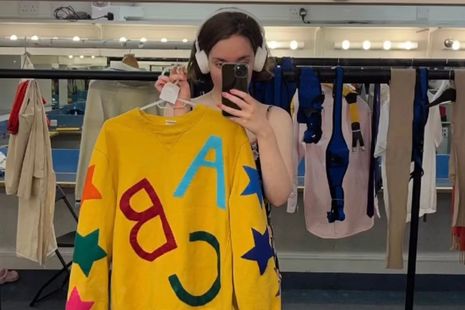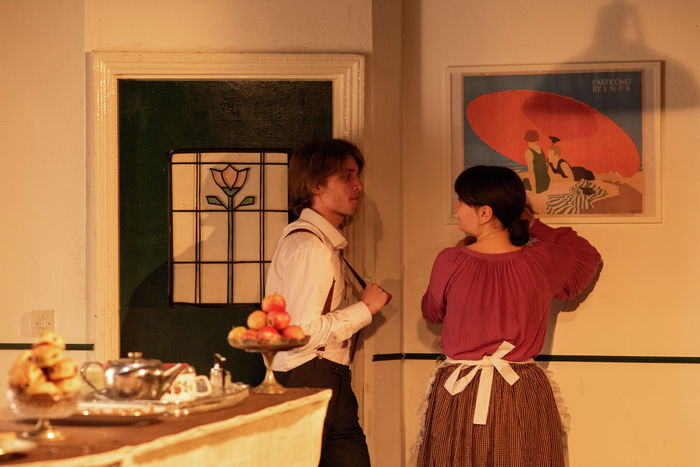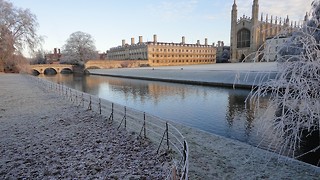Sewing machines, Vinted and a residency in the ADC dressing room: life as a Cambridge costume designer
Lily Butler explores what it means to be part of Cambridge theatre’s most neglected prod community

Tucked at the bottom of a show’s application pack, you’ll inevitably find a plea for a costume designer. Every show needs someone to make sure the actors aren’t performing in the nude – and, more importantly, that they look good. Yet what exactly does a costume designer do? I spoke to two, Abi Beton and Rose Beedle, about what they love about their roles and how they go about them – but also the issues they face as one of the most underrated crew members in Cambridge theatre.
Costuming is, first and foremost, an art form. Both Rose and Abi had experience before Cambridge, but found that the ADC gave them the opportunity to display this to an audience. Both have been involved in a wide range of shows, from musicals to short films, which have varying demands, but also a lot of creative freedom. Rose detailed this variety: “A musical, for example, will often require costumes an actor can dance in. Shows might require costumes that can be fought in, have fake blood spilled over – you name it. Part of the fun of being a costume designer is going through the script and seeing how you are going to make the costumes with these requirements in mind.” Abi summarised the process as “LOTS of time spent on Vinted and at charity shops to get all of the costumes you can find for as cheap as you can get them” – as well as having to get inventive. When designing for The Complete Works of William Shakespeare (Abridged) in Michaelmas, Abi used unconventional props, such as balloons and ankle socks, to create a range of eccentric costumes. For those considering dipping their toes into the role, Rose describes it as having a lot of creative freedom and control, but without the stress of overseeing multiple aspects of the production, as is the case with directing.
“Costume designers in Cambridge theatre just don’t receive the same amount of credit”
Yet despite the effort put in, it’s clear that costume designers in Cambridge theatre just don’t receive the same amount of credit for their labour as other members of a production, even among the cast and crew themselves. According to Rose, the one thing she would want to change about her job is the “appreciation for costuming as an art form, both by the rest of the show’s team and by reviewers”. Too often a review will only mention tech when something goes wrong, ignoring the many hours of work that go into costumes and which make a show more immersive. Yet when costumes are done well, it truly enhances a production. Regarding Abi and Rose, look to the reviews for Emma and The 25th Annual Putnam County Spelling Bee respectively to see proof of how their creativity built upon the overall vision of the show.
The somewhat dismissive attitude towards designers reverberates throughout the ADC. There are few people who can rise to the challenge of sourcing historically accurate Regency dresses, and so there are too few people who can voice the current problems with costuming – and this is part of the problem. Rose (whose first costuming role was as an assistant seamstress) discussed the importance of making the role more accessible to beginners: “I know a lot of people who enjoy sewing but are intimidated by the responsibility of the ‘costume designer’ title.” She stressed the need to make it “more accessible to become an assistant seamstress on a project”, as she believes such measures would make “a big difference to people’s confidence”. Abi discussed the possibility of there being skill-based sessions: “It would be great to have an introduction to the sewing machines and how to use them, how to read and follow a pattern, how to take accurate measurements and alter a garment. These are all good life skills that I hope would help to make costuming less daunting as well!”.
“Rose describes the role as having a lot of creative freedom and control”
But what can be done to improve the experience when you actually get the role? Abi and Rose have both experienced a sense of “odd isolation” when working: “You only meet the cast for necessary fittings, etc., which generally makes it feel like far more of a professional relationship…I hope more prod teams in the future will make it explicit that costume designers (and other crew members) are welcome at socials and that the cast should make an effort to get to know them” argues Abi. This is indicative of the ever-present problem in the ADC where crew members are somewhat ignored by the more visible roles in a production, which only goes on to create more issues. Perhaps the sense of anonymity is why cast members may not make sending their measurements a priority, or why a director may underestimate how much time it will take to costume an entire cast – which only furthers this sense of isolation.
Yet these are not unnavigable obstacles. When I asked about possible solutions, both gave their answers in literal bullet-point lists, indicating how glaring the problems are but also how simple it would be to fix them. Abi’s suggestion of advertising for a team of designers could do wonders for managing the workload (she previously described spending entire days sewing in a dressing room: a horrifying prospect for any student with a demanding degree to balance), while also addressing Rose’s concern about a lack of awareness for the demands of the role.
Making a dress takes time. Making dresses to fit an entire cast takes even more time. Making dresses while balancing a rigorous Cambridge degree can take something out of you – unless the current issues are addressed. Even acknowledging this fact is an important step in shifting the disparaging attitudes held towards costume designers. So, to the actors and crews of Cambridge theatre: the next time you allocate a budget or wonder where your outfits are coming from, make sure to save your costume designer a space at a social to ask them about it. Or at very least send in your measurements on time (“Please”).
 Comment / Anti-trans societies won’t make women safer14 November 2025
Comment / Anti-trans societies won’t make women safer14 November 2025 Fashion / You smell really boring 13 November 2025
Fashion / You smell really boring 13 November 2025 News / Controversial women’s society receives over £13,000 in donations14 November 2025
News / Controversial women’s society receives over £13,000 in donations14 November 2025 Features / Beyond the Pitt Club: The Cambridge secret societies you have never heard of16 November 2025
Features / Beyond the Pitt Club: The Cambridge secret societies you have never heard of16 November 2025 News / Pembroke flood damage forces ‘costly’ repairs17 November 2025
News / Pembroke flood damage forces ‘costly’ repairs17 November 2025










